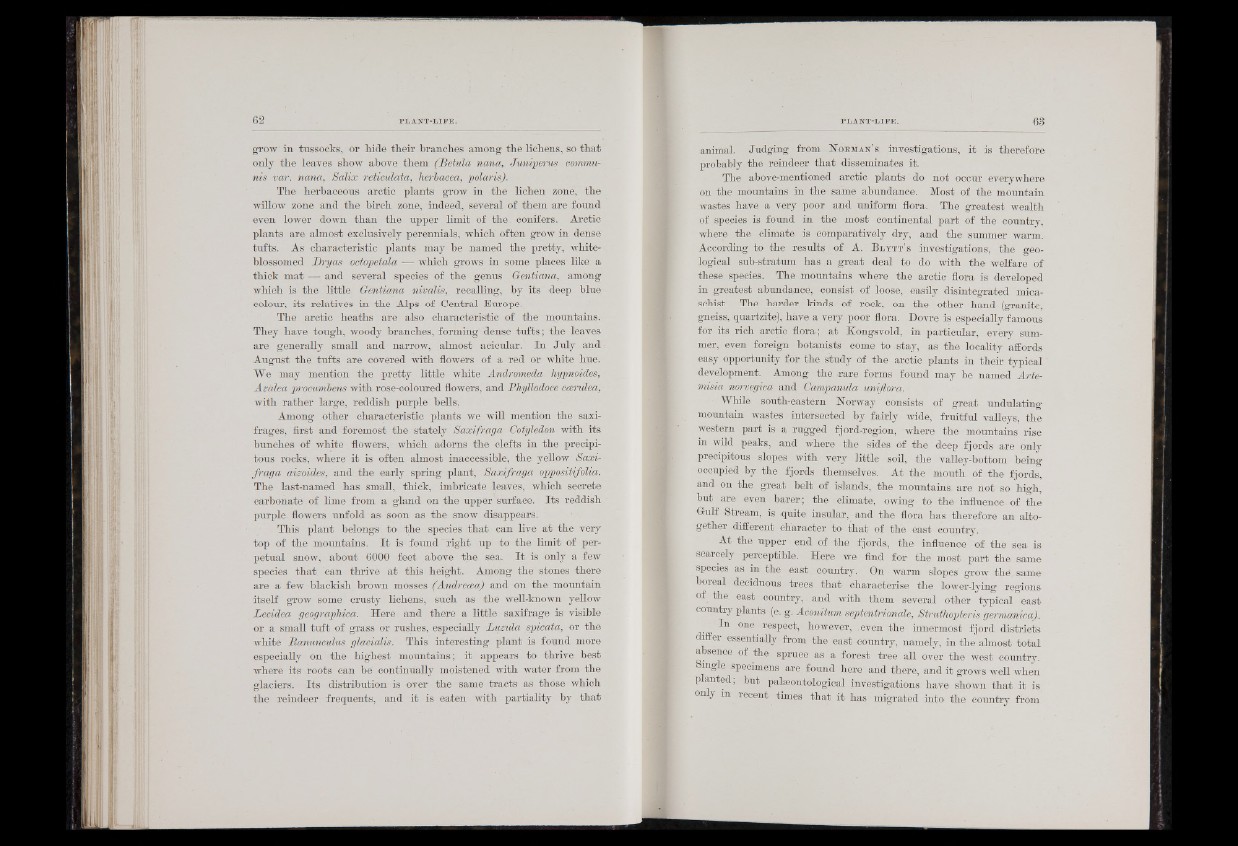
grow in tussocks, or hide their branches among the lichens, so that
only the leaves show above them (Retula nana, Juniperus communis
var. nana, Salix reticulata, herbacea, polaris).
The herbaceons arctic plants grow in the lichen zone, the
willow zone and the birch zone, indeed, several of them are found
even lower down than the upper limit of the conifers. Arctic
plants are almost exclusively perennials, which often grow in dense
tufts. As characteristic plants may be named the pretty, white-
blossomed Dryas octopetala — which grows in some places like a
thick mat and several species of the genus Gentiana, among
which is the little Gentiana nivalis, recalling, by its deep blue
colour, its relatives in the Alps of Central Europe.
The arctic heaths are also characteristic of the mountains.
They have tough, woody branches, forming dense tufts; the leaves
are generally small and narrow, almost aeicnlar. In July and
August the tufts are covered with flowers of a red or white hue.
We may mention the pretty little white Andromeda hypnoides,
Azalea procumbens with rose-coloured flowers, and Phyllodoce ccerulea,
with rather large, reddish purple bells.
Among other characteristic plants we will mention the saxifrages,
first and foremost the stately Saosifraga Cotyledon with its
bunches of white flowers, which adorns the clefts in the precipitous
rocks, where it is often almost inaccessible, the yellow Saxi-
fraga aizoides, and the early spring plant,' Saxifraga oppositifolia.
The last-named has small, thick, imbricate leaves, which secrete
carbonate of lime from a gland on the upper surface. Its reddish
purple flowers unfold as soon as the snow disappears.
This plant belongs to the species that can live at the very
top of the mountains. I t is found right up to the limit of perpetual
snow, about 6000 feet above the sea. I t is only a few
species that can thrive at this height. Among the stones there
are a few blackish brown mosses (Andrecea) and on the mountain
itself grow some crusty lichens, such as the well-known yellow
Lecidea geographica. Here and there a little saxifrage is visible
or a small tuft of grass or rushes, especially Luzula spieata, or the
white Ranunculus gladalis. This interesting plant is found more
especially on the highest mountains; it appears to thrive best
where its roots can be continually moistened with water from the
glaciers. Its distribution is over the same tracts as those which
the reindeer frequents, and it is eaten with partiality by that
animal. Judging from N o r m a n ’s investigations, it is therefore
probably the reindeer that disseminates it.
The above-mentioned arctic plants ' do not occur everywhere
on the mountains in the same abundance. Most of the mountain
wastes have a very poor and uniform flora. The greatest wealth
of species is found in the most continental part of the country,
where the climate is comparatively dry, and the summer warm.
According to the resulta of A. B l y t t ’s investigations, the geological
sub-stratum has a great deal to do with the welfare of
these species. The mountains where the arctic flora is developed
in greatest abundance, consist of loose, easily disintegrated micaschisti
The harder kinds of rock, on the other hand (granite,
gneiss, quartzite), hâve a very poor flora. Dovre is especially famous
for its rich arctic flora ; at Hongsvold, in particular, every summer,
even foreign botanists come to . stay, as the locality affords
easy opportunity for the study of the arctic plants in their typical
development. Among the rare forms found may be named Artemisia
norvegica and Campanula umftora. ■
■ While south-eastern Norway consists of great undulating
mountain wastes intersected by fairly wide, fruitful valleys, the
western part is a rugged fjord-region, where the mountains rise
in wild peaks, and where the sides of the deep fjords are only
precipitous- slopes with very little soil, the valley-bottom being
occupied by the fjords themselves. At the mouth of the fjords,
and on the great belt of islands, the mountains, are not so high,
but are even barer; the climate, owing to the influence-of the
Gulf Stream, is .quite insular, and the flora has therefore an altogether
different character to that of the east country.
At the upper end of the fjords, the influence^" of the sea is
scarcely perceptible. Here we find for the most part the same
species as in the east country. On warm slopes grow thé. same
boreal deciduous trees that characterise the lower-lying regions
of the east country,. and with them several other typical east
country plants (e. g. Aconitum septentrionale, Struthopteris germanica).
In one respect, however, .even the innermost fjord district's
differ essentially from the east country, namely, in the almost total
a sence of thè spruce as a forest tree all over the west country,
bingle specimens are found here and there, and it grows well when
p anted, but palæontological investigations have shown that it is
° y in recent times that it has migrated into the country from